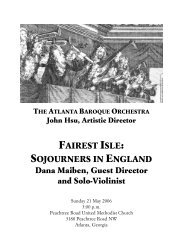Dieterich Buxtehude Membra Jesu nostri - Atlanta Baroque Orchestra
Dieterich Buxtehude Membra Jesu nostri - Atlanta Baroque Orchestra
Dieterich Buxtehude Membra Jesu nostri - Atlanta Baroque Orchestra
Create successful ePaper yourself
Turn your PDF publications into a flip-book with our unique Google optimized e-Paper software.
devoto tibi pectore. temet ipsum tunc ostende<br />
devoted to thee, on thy breast. then show thyself to me<br />
(Vulnerasti repetatur) in cruce salutifera.<br />
upon the cross which brings salvation.<br />
VII. AD FACIEM<br />
TO HIS FACE Amen!<br />
Soprano I, Soprano II, Alto, Tenor, Bass Program note<br />
Illustra faciem tuam super servum tuum; <strong>Dieterich</strong> <strong>Buxtehude</strong> was the foremost musician in Germany during<br />
Let thy face shine upon thy servant; his active career, and with this concert the <strong>Atlanta</strong> <strong>Baroque</strong> <strong>Orchestra</strong><br />
observes the 300 th anniversary of his death and the 370 th of his birth.<br />
salvum me fac in misericordia tua. It is not known precisely when or even where he was born, but the<br />
make me safe in thy mercy. best deduction from available evidence is that he was 70 when he<br />
(Psalm XXXI:17) died in 1707 (and therefore born in 1637), and that he was born in the<br />
city of Helsingør (the location of the castle in which Shakespeare set<br />
Alto, Tenor, Bass his play Hamlet). The fact of his pre-eminence during his lifetime is<br />
Salve, caput cruentatum, demonstrated by the fact that more of his music survives — perhaps<br />
five or six times as much — as any of his contemporaries, more than<br />
Hail! O head stained with blood, any other besides J. S. Bach. (In fact, Bach himself is responsible for<br />
the preservation of a very large proportion of <strong>Buxtehude</strong>’s organ<br />
totum spinis coronatum, music.)<br />
all crowned with thorns,<br />
In one important respect, <strong>Buxtehude</strong>’s career was a mirror-image of<br />
conquassatum, vulneratum, Bach’s. In spite of the fact that he was an organist, Bach spent the<br />
disfigured and covered with wounds, final and longest stage of his career as music-director for the churches<br />
of Leipzig, composing music for his choirs and conducting them,<br />
arundine verberatum, and doing some organ-playing on the side. <strong>Buxtehude</strong>, on the other<br />
struck with a rod, hand, remained an organist for all his life, most especially at the<br />
church of St. Mary in Lübeck, where he presided over the great<br />
facie sputis illita. organ for 40 years, from 1668 until his death. In that capacity he<br />
the face spat upon and soiled. played a great deal of organ music (improvised, as was the custom<br />
of the time — any music which was written down and survives to us<br />
Alto was copied out for the sake of his students, to play and to use as<br />
Dum me mori est necesse, models for their own composing). The direction of the choir, how-<br />
If for me to did must be, ever, was in the hands of another musician; indeed, the choir was so<br />
far away from the organ (choir near the altar at the east end of one<br />
noli mihi tunc deesse, of the largest church-buildings in Germany, and the organ high in a<br />
do not be absent from me, gallery at the west end) that <strong>Buxtehude</strong> could have had nothing to<br />
do with the choral parts of the liturgy. But there were several galleries<br />
in tremenda mortis hora at the west end of the church, high and close to the organ, from<br />
in the dreadful hour of death; vocal and instrumental soloists performed during Communion, and<br />
it is for these circumstances that <strong>Buxtehude</strong> wrote the major por-<br />
veni, <strong>Jesu</strong>, absque mora, tion of his cantatas.<br />
come, <strong>Jesu</strong>s, without delay,<br />
All of his music — the organ works like the “præludium” on this<br />
tuere me et libera! program, the chamber music, and the cantatas — are single-<br />
protect me and set me free! movement compositions, but within each single movement there<br />
are a variety of tempos, meters, and textures. In this regard,<br />
Soprano I, Soprano II, Alto, Tenor, Bass <strong>Buxtehude</strong>’s music is much like the madrigals of Monteverdi and<br />
Cum me jubes emigrare, Marenzio or the toccatas of Frexcobaldi and Froberger. It was not<br />
When thou biddest me leave this world, until two generations later, the generation of Bach and Handel and<br />
Vivaldi, that these various sections within the single movement be-<br />
<strong>Jesu</strong> care, tunc appare, came expanded and separated into distinct movements.<br />
dear <strong>Jesu</strong>s, then appear<br />
O amator amplectende,<br />
O lover whom I would embrace<br />
,








